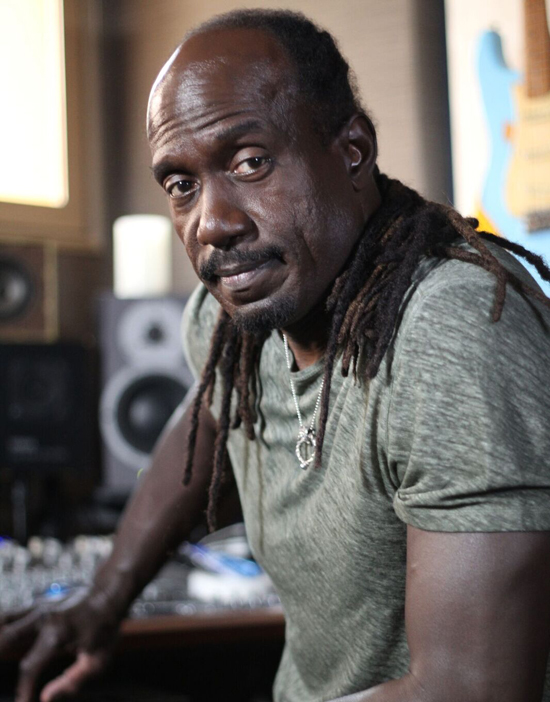
photograph courtesy of 825 Records
Vocalist Curtis King Jr. is certainly recognizable to Bruce Springsteen fans the world over. He first started working with Bruce in 2006 as a part of the touring Seeger Sessions Band and later became a member of the extended E Street Band for the 2009-2014 tours. In addition to his work with Springsteen, Curtis has had a long and successful career in the music business. As a backup singer and studio musician for more than three decades, Curtis has worked with a who's-who list of music industry giants: from Duran Duran, David Bowie, and Billy Joel, to Madonna, Joe Cocker, and countless others. Curtis has also appeared over the years on Saturday Night Live and on Late Show with David Letterman, backing up musical guests like Stevie Wonder and Darlene Love.
Curtis was nice enough to sit down recently with Backstreets writer Erik Remec to talk about the release of his very first solo album Changing Face and about his experiences working 20 feet from Springsteen.

You've had a very successful career in the music business for over 30 years, so what made you decide that this was the right time to put out your first solo album?
I started going into the studio around 1996 and tried recording just to see if I could do it. I played around in the studio a bit, but then the tours called. I got a call from Duran Duran to go out on tour, and then Carly Simon asked me if I would go out on tour with her [while I was on tour with Duran Duran]. As crazy as it was, the open dates I had were the dates that she had booked. So she flew me back and forth between Duran Duran and her tour. Along the way I recorded a song here and there; you know, at least I was writing, but it just wasn't coming together.
I had a lot of songs, but it became a whole other journey of finding the songs that I felt fit me. I had written songs that I liked, but they were not necessarily for me — maybe a cool song from a writer's perspective, but now I'm thinking of me as the artist, so I had to start writing from that vantage point. It just took awhile to kind of find my own voice in all of that.
I officially started, believe it or not, just the year before Bruce called for the Seeger Sessions Tour, in 2005. My [Changing Face] co-producer Butch Jones had been bugging me about really locking in on the album, and as soon as I lock in, Bruce Springsteen called.
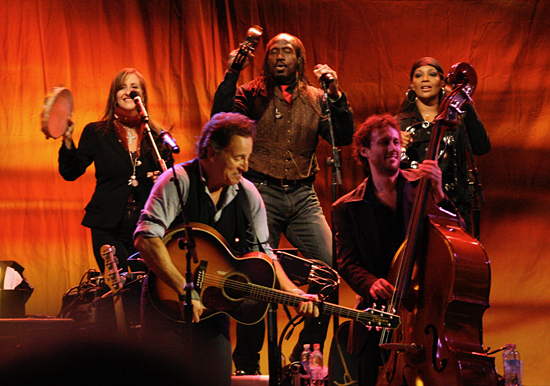
Verona, Italy, October 5, 2006 - photograph by Mauro Regis
So how did the whole Bruce thing start?
I got a call from Steve Jordan [drummer/producer who has worked with Patti Scialfa among many others] in 2006. He said that Bruce Springsteen had been auditioning male singers for the Seeger Sessions Band and hadn't come up with anybody that he liked, and he thought I would be the perfect guy for him. I'm really grateful to Steve Jordan for helping me out like that.
The band was rehearing at the Convention Center, I think, at the time.
So I walk in, and Bruce introduces me to the guys, and then he starts to sing and asks me to harmonize with him. I sang some harmonies, and Bruce says, "Okay, that sounds good, come up on stage." I said, "But I don't know the material!" And Bruce says, "Don't worry — you'll learn it along the way." That was my audition!
How would you describe your sound on Changing Face?
Well, I'm sort of a chameleon in some respects, vocally, in that my influences are wide and vast. I'm a really big fan of Bobby McFerrin. I really like doing [his type of] little vocal stylings. And then, of course, I'm a big fan of Marvin Gaye, Paul McCartney, and the Beatles. I just love their music.
You covered Paul McCartney and Marvin Gaye on the album?
Yeah — "My Love” and "Can't Buy Me Love,” and Marvin Gaye's "Come Get You This," from the Let's Get It On album. Whenever you're doing a remake of a song, you really need to take it somewhere else so that the song will still be recognizable, but different from the original. That's what I like to hear. If you're going to pay tribute to a song, then really flip it on it's head. So I did that with the Marvin Gaye song and also the Paul McCartney songs. I took "My Love" and slowed it down and just turned it into this big romantic song. And then "Can't Buy Me Love" I turned into a really fun a cappella song.
You met Paul McCartney, right?
I did meet him. I met Sir Paul when we did the Grammys. I forget what year it was... we were touring like mad, it might have been 2012. I was backstage at the Grammys with Garry Tallent, and Sir Paul was there. Garry and I were talking about how it would be great for me to meet him. Garry said, "Just go say Hi — he's cool” and that's what I did. It was just a perfect opportunity. You know, things happen, and you just know that they're going to happen. I've always wanted to be the fifth Beatle. Of course that never happened, but just to be in his presence, and my favorite Beatle on top of that, it was just an amazing experience. He's a very, very nice man.
 Hyde Park, July 14, 2012 - photograph by Geoff Robinson
Hyde Park, July 14, 2012 - photograph by Geoff Robinson
And you were also at the show with him when they turned the power off?
Yes, I did the "power off" show! I was there — was it Hyde Park?
Yeah, Hyde Park.
We were playing and having a rocking good time, and all of sudden you could hear that something went wrong [chuckles]. Something went awry, and we could tell the power was definitely off out there in the audience. We were past our curfew!
And then, as luck would have it, we had another couple hours just hanging out with Sir Paul. We couldn't leave, since we had overshot our time — usually we leave the stage before the audience is gone, but since we went overtime, they had to let the audience get out to get to the subway, which of course blocked our little escape. So it actually all worked out well in the end.
So what did you learn from working with Bruce?
He has a great work ethic, just really amazing. You're there on a mission, and you have a job to do, and you work the entire time that you're there. You're on a great tour, you're going to some amazing places, and everybody's being treated [as equals]. Bruce, to me, is just so gracious to have us be a part of his world. I just find that so incredible, because he didn't have to do that. He shared all of what he was experiencing with us. I've been around people who were gracious, but he is truly, I would say, almost unmatched in that respect.
But you gotta work, right?
Yes! From the moment we started, I was working. When we stopped, I could feel it in my body: it just literally dropped once the tour was over. I collapsed. Mentally, it's draining too because Bruce always keeps you guessing. He would have us learn new stuff on our off days. He'd want us to learn the new songs so that we'd be ready when he calls us at the soundcheck rehearsal. And then hopefully you've done your homework, because when you get up on stage you might be doing that song as the opener!
He would surprise you. It would be a rush. We're riding this untamed mare that's out there, and we're just trying to hold on for dear life, trying to ride it and not get kicked off. It was just such a blast. It taught me about being spontaneous. The spontaneity is very much a part of how Bruce works. No two shows were alike. Ever.
Did you get the set lists beforehand?
You get the set list just prior to going on stage. You get it, and within three to five minutes you're walking towards the stage. You're looking at it, and you're just trying to take it all in while the stage lights are coming up!
And then the setlist might change during the show anyway.
Yeah — and nine times out of ten, it would!
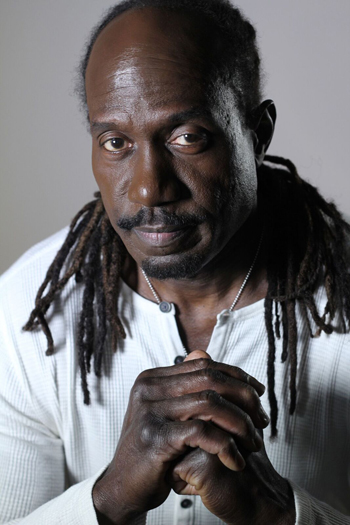 Back to your album, what was the recording process like?
Back to your album, what was the recording process like?
Butch Jones was the catalyst for me. I'd see him on a session, and he was always asking me when I was going to do my own record. He had this new equipment that allowed us to record anywhere — we didn't need to go into an actual studio — so that made it easier for me. We ended up going to an office, and he'd just set up his equipment, completely mobile, and we'd start recording. The office had a soundproof room that allowed me to be able to sing in there, and we basically made the record there and in the basement of his house. Only once or twice were we in an actual studio.
photograph courtesy of
825 Records
Butch was just so gung-ho and really stayed on it. He was checking in with me while I was on the road. I would send him my ideas, and then he would put them in the track, and I'd come back and just tweak it. I learned a lot from this whole process through Butch. He taught me how to create space on the record. He let me know that you have to leave room. You have all these instruments, and everything has to be able to breathe and have its own space so you don't crowd the record. I had to make sure that each of the ideas [I had] had its place, and I had to make sure I wasn't overindulging with too many ideas at once.
So is there a general theme to the music on the record?
Changing Face represents that I'm not just one particular genre. It represents all these different parts of me, because I never liked the idea of making a "soul record" or a "pop record." One of my mentors, Todd Rundgren, never liked being put into a box, and that's how I wanted to approach my own record.
It does make it a little harder to market the album, then...
It does. But the way I look at it, you listen to my record, and you hear this single, and you go, "Wow, that's cool!"... and then you start checking out the rest of the record, and you go, "Wow, that's different — I didn't expect that, but I still like it." Maybe it's just me, but it seems like [on a typical record], you got the one single — the hit — and then every song sounds similar to that. I like to write something for each song that's really unique and not in any particular direction. I really feel that once I get out and perform the album, people will get it even more. Once they hear it live.
But there is a common sound to it all, though. It's not completely different from one track to another. It's not like you're doing country and then heavy metal!
Well, right, it's not that different! Although if you really listen to it, I think that my song "Still Looking for You" could be a country song. I've been singing it around the house lately with a little more of a twang to it, and I'm thinking, "Oh, I think I have my country song here too!"
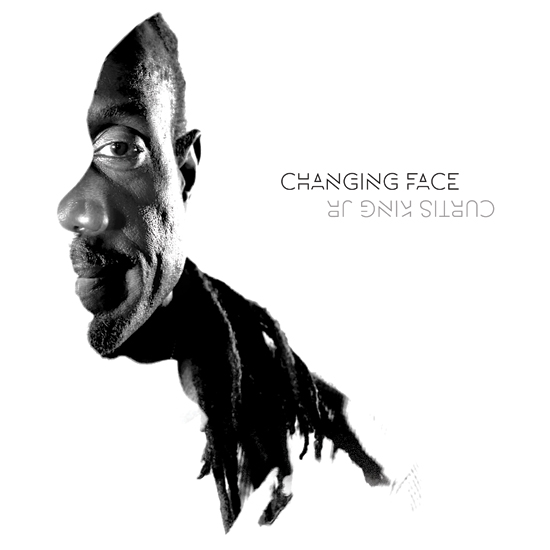
What kind of idea are you going for with the album cover artwork?
The cover kind of gives you the whole "Changing Face" thing too. I'm getting a lot of kudos for it. It's from an idea that I came across a couple years ago. I explained [my idea] to Matty [Amendola], who did the album artwork and did my website, and he said, "I could do that." He snapped some photos of me and worked on putting this whole thing together.
Let's talk a little more about some of the other songs on the album.
"Little Feet” is the first song on the album. I call it a little vignette. It's not very long, and it's just a taste of something really cute and fun. I call it "Little Feet” because it reminds me of a child running around the house, something really light and funny.
I initially wanted [African singer] Angelique Kidjo to do a duet with me on the song "Shine." I sent the song to her, but [instead of a duet] she gave me a lot of African ad-libs. She did something completely different from what I had originally planned, but it worked. "Shine" is almost like two songs. I was listening to that song in the studio, and I got this idea of creating another section, a continuation of the song going off in another direction. I found a chord which I felt would really work, and it just opened up a whole new world.
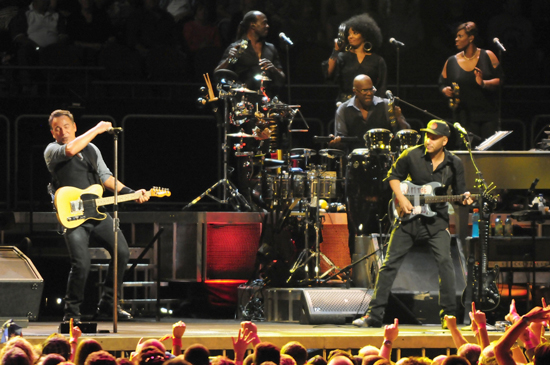
The Wrecking Ball tour down under - Sydney, Australia, March 18, 2013 - photograph by Rene van Dimen
You have some other singers on the record too.
Yes. I was able to get [fellow E Street/Sessions Band vocalist] Cindy Mizelle, Dennis Collins, Fonzi Thornton, and Lisa Fischer. I was really fortunate to get these really top-tier players. I had the girls on "No Sign of Religion," and both the girls and the guys on "Living in Color," "Nothing About My Heart," and "Wildest Dreams."
The events of September 11th inspired me to write "No Sign of Religion." I sat on that song for a while, because I wasn't exactly sure how to write it. I didn't want to write just about the towers or just about that moment. I wanted [the events of 9/11] to be a part of the song but not the core of it. I wanted to try and put images in your mind when you listen to the song and you hear the lyrics. When I sing it, I can see the events of the day. My son or my little girl would ask, "We're saying all these prayers, but why is God letting this happen?" It's a great question. It's something I grew up with, and I still don't understand why these terrible things happen. And religion can be such a thorn in everybody's side. "I've got mine, and you got yours," and everyone thinks theirs is better than the other's. We're all one here, you know?
The song "Living in Color" deals with your experiences with racism.
My son, who was in the fifth grade at the time, came home from school one day and told me that one of the kids at his school had said a very-not-so-nice word [the n-word] to him, and he's asking me, "What's that?” I was just shocked to hear him tell me that. So that was the catalyst for the song. "We're still living in color." I didn't want to offend anyone with the song — I just wanted people to get it. I was angry when I heard [what my son went through], and I wanted to express myself through the music and get the message across to folks. That was my aim with that song.
It's a shame that racism is still such an issue.
I had gone through it. That's what I dealt with. I thought, before my son had come to me, that it had passed and that we were on to better days. And here we are. I still can't believe we are where we are today.
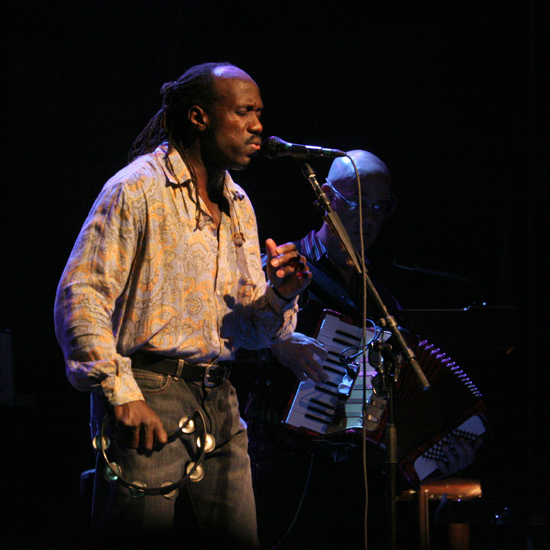
Frankfurt, Germany, May 17, 2016 - photograph by Riku Olkkonen
So what are the plans now with the album? Are you going to go out on the road or play some shows?
Well, the plan is to have a nice little listening party, preferably at The Cutting Room [in New York], and then to play some shows and get this thing up and running.
What kind of a band would you be thinking of?
Well my bucket list band would be... let's see, for bass players: it's a choice between Anthony Jackson and Will Lee. Omar Hakim was the drummer on at least three songs on the record; it would be great if I could get him to be there as well. See, I'm also thinking of musicians who also sing, so they could also then add the voice.
Double duty.
Right. Will [Lee] sings. Omar sings. For guitarists: Ira Siegel and Larry Saltzman from The Mar-Tays — they're two of my favorite guitarists. For the horn section, I'd like to get V. Jeffrey Smith, who did the horn arrangements on the record, and his sidekick Mark Williams, who played trombone.
I would like to have at least five singers, maybe six, to pull this all off, for all the vocal things I have going on. Also, I play keys, but I would like to have someone doubling me so that I would be able to jump off and stand up and sing if I want. So that's my plan. I'd like to have that freedom to be able to move around without thinking about it and then come back to keyboard when I need to.
It's quite the production!
Yeah, it's a fairly sizeable band. And it would be a pretty rocking band. See, I want to take the songs on the record and take them a little step higher, turn it up, really liven it up. And those songs, those vocal vignettes, my idea would be to really pull them off and really kill. That's what I plan to do.
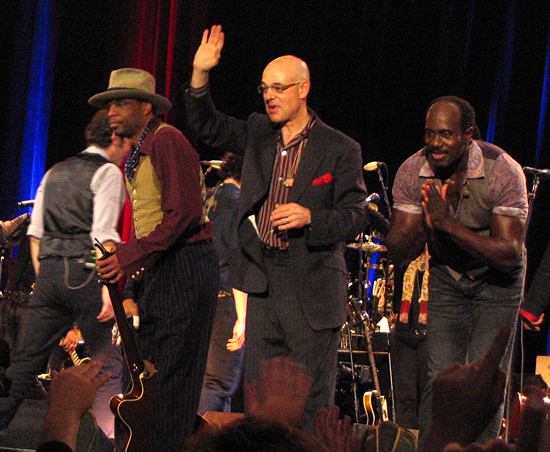
Dublin, Ireland, November 19, 2006 - photograph by Geoff Robinson
Very cool. You also have Charlie Giordano on the record.
Yeah, I had Charlie on "Shine" and "Changing Face." He played the accordion, and he did a really beautiful job. I don't know if you're aware since Charlie doesn't play piano with the E Street Band, but he's an amazing piano player. I go back to the Seeger Sessions, all that ragtime stuff that he was playing, and it's funny, but I forgot about that once I got to E Street. Because, you know, E Street's a different kind of animal. And then one day we were in rehearsal, and Charlie just started playing piano, and I said, "God, I forgot how beautifully he plays piano, man!” So he may be someone that I may consider to take on that position — if he's available, of course. Plus, he covers all kinds of keyboard instruments, so he would be really good. So I'm just keeping all these great people in mind, and hopefully their schedules would allow them to be available.
Are you thinking of just a few dates, here and there?
So far, dates here and there. I haven't quite figured it out yet, but I would like to get some radio play. It's been bit of a journey with this whole record. It took me quite a few years to get it done, with all the touring and everything. It also took me a while to sit down and listen to it and really appreciate it. When I listened to the final product, I said, "Wow, this sounds really good! This is really something!" Butch did an incredible job on this thing. I'm getting a lot of great response from people — they're really liking it. They have their favorites: some people like "Shine," some like "Still Looking for You," and "Changing Face" gets a lot of love. And even now, when I'm listening to the record, I got all these new ideas for it! Okay, maybe I could apply them in a live situation... or to the next record. I'm ready to write the next thing.
You know, the excitement is still there for me in this business. I'm just a happy background singer and grateful to be a part of the scene and add my voice. It's just such a wonderful life — not to quote a movie, but it kind of is!
Changng Face is available now. Visit Curtis's official website at www.curtiskingmusic.com






